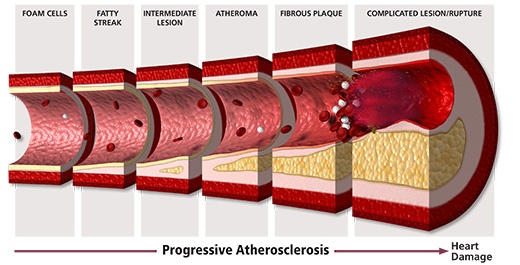National cholesterol education month is a great time to review why controlling blood cholesterol levels is so important to keeping a healthy heart. Several major risk factors for heart disease have long been identified and when present together create a perfect storm that can wreak havoc in the lining of the arteries of your heart. When cells of the lining of an artery become damaged, openings are created. It is this initial damage that allows the excess cholesterol in your blood to enter the lining of the artery and grow into plaque. Overtime, worsening plaque narrows or blocks blood flow and can lead to a heart attack. Preventing damage to the lining of arteries is the key to avoiding heart disease, but also to avoiding a recurring event if you already have heart disease. Here are 4 steps you can take toward maintaining healthy arteries and a healthy heart.
- If you smoke, quit. Easy to say, difficult to do. But consider this step as the single most beneficial step you could make toward stopping any further damage to your arteries.
The toxins in tobacco smoke are absorbed through the lungs where they enter your arteries. Once inside, these toxins can cause damage and then inflammation in the artery lining. This can be the initiation of heart disease. The good news is that there is lots of help available online and many have been able to kick the habit. You can too. Speak to your health care provider about your options.
- If you have high blood pressure, control it. The pressure or force of blood flow through the arteries can also lead to damage of the artery lining. Weight loss, if needed, is your first step. A loss of as little as 10 pounds can sometimes be enough to bring your blood pressure to the normal range. Routine physical activity is also beneficial. Lowering the amount of salty foods you eat and increasing the amount of potassium rich fruits and vegetables is a good move to help bring blood pressure down. Meditation has also been shown to be beneficial in helping to lower blood pressure.
- If you have high LDL cholesterol, lower it. Too much LDL cholesterol floating around in your arteries means it can easily be taken up into the damaged lining starting the process of plaque formation. There are many things you can do to lower it. The first step is to make changes to your diet. Lowering saturated fat and increasing dietary fiber are most important. Many foods can be added to your diet that will be helpful. Routine physical activity and weight loss can also do wonders to bring your LDL under control. If diet, exercise, and weight loss are not enough, your health care provider may prescribe cholesterol lowering supplements and/or medication.
- If you have high blood sugar, lower it. Just like tobacco toxins, high blood sugar damages arteries and initiates the process of plaque formation (howmed). Weight loss, specifically losing body fat can help tremendously. Also getting more physical activity and reducing sedentary time is very helpful. Aim for getting 150 minutes of moderate physical activity per week. Finally, what you eat and how much can contribute. Going easy on high carbohydrate foods and limiting any sweets and sugar sweetened drinks are good first steps.
During cholesterol education month, why not make it a priority to control these major risk factors? Preventing damage to your arteries or stopping any further damage is a good way of taking care of your heart. It’s the only heart you have— get started today!
